Short Films
shown in Galerie De Pieter or Aalmarkt 15 More about the exhibitions >>
Bird of Flames – dir: Chel White, prod: David Lynch, U.K.
9 Times – animation: SansCulotte music: 9 Times LP
Dawn of the Rainbow – animation: Katie Godwin, U.K.
soundtrack: Wayne Urquhart, U.K.
to be or not to be – Mehdi Zarei, Iran (watch)
Vertige – dir: Christophe Gautry + Mathieu Brisebras,
sound: Jean-François Cavro. Shot in Toyko, produced in France.
Dankumba – dir: Bakary Diallo, photography: Sylvain Briend,
music:Pacifique, Kati, production: Le Fresnoy, France
Plural – Dan Inglis, New Zealand (watch)
Gotland & the Infinite Whistle – by Juliacks, Sweden sound score: a live performance with MAG, the audience and Juliacks at an event produced by GRRRNDZERO in Lyon, France (watch), 2012, 9 min
Footage from Almedalen Week- an eco-rock festival in Gotland. The actions appear to be rituals for mother earth
New Hippie Future – by Dalibor Baric, Croatia (watch), 2011, 4 min
Surreal stop motion collage featuring a butterfly collection.
El Sandara / The attic – Mohamed Shawky, Egypt (watch)
CRJYKLCW – dir: Pierrick Servais, prod: Tapas Films, France
Disfire – dir: Clement Mona, prod: Alligator Studio, France (trailer)
Esctatic Mould –
Eyewitness –
Between Regularity and Irregularity – Tsutani Masahiro, Japan
(synopsis + stills)
Disturbdance – by Guli Silberstein, UK / Palestinian Territories / Israel (watch), 2012, 3 min 26 sec
A woman waves her hands and jumps around to stop two soldiers shooting at people in her village. The footage is slowed down and pixelized so the gestures appear to be like a dance between three partners.
Portraits d’Ombre – by Anne-Lise King, France (watch), 2012, 3 min
Wire sculptures create shadows in the sand reminescent of human faces. Music: mandolin + cello.
Behind The Window – Nagham Abboud (watch)
Carbon – animation/dir: Dylan Ladds (watch)
Anoesis – Mounia Akl & Cyril Aris, Lebanon (watch)
Dot in the line – by Basir Mahmood, Pakistan (watch), 2012, 1 min
Pun on the fable, the tortoise and the hare.
For the following films you need to email Sonja for the password
Robo Cats in Titan City – Paul Wiersbinski, Germany (watch) 5 min 4 sec Documentation of his video installation which touches on various social theories related to media and perception.
Why Not Kill a Fly! – Farhad Alizadeh, Iran (watch) 5 min. A cleverly drawn and designed animation.
Suddenly, Last Summer – Juha Mäki-Jussila, Finalnd (watch) 4 min 19 sec Stop animation featuring the plant world. The soundscapes, snipbits from old films, introduce an unease.
The Night of Badr – Mehdi Hmili, Tunisia (watch) 25 min. Black + White, French with English undertitles. Months after the Tunisian revolution, Badr, an elderly famous poet is called from his exile to return to Tunisia. He spends his last night in Paris with his young lover Philippe. Is a man who maintained his intellectual liberty for years, prepared to maintain his sexuality in his country where homosexuality still is a taboo?
Sea – Miia Rinne, Finalnd (watch) 5 min 43 sec The sound of the sea accompanied by paintings and film glitches. Midway the sound mutates as if affected by the visual mutations. Visually stunning.
Kingdom of women – Amna Ehtesham Khaishgi, Pakistan/United Arab Emitrates, music: Muqeem Khan (watch), 2011, 9 min.
A camera on the move in a woman’s world – the Meena Bazar in Karachi which is open only to female entrepreneurs and customers.
The Floating World – Ian Campbell, Canada (watch), 2012, 8 min 32 sec.
A beautifully surreal and nostalgic world
Morning Fears, Night Chants – Roula Lattkani and Salma Deiry, Syria (watch) Prod: Syrians Within Borders, 25 min. Arabic with English subtitles
The film centers on a young woman who sings melodic songs of protest about the terrors happening in her country. These songs are a form of liberation – her own revolution against the repressions within herself, those against Syrian citizens.
Wojoh (Faces) – Said Najmi, Jordan (watch), 2012, 38 min
Vivid snapshot of Bedouin family life in the Jordanian Petra desert.
The very sad story of the augustus – Ozge Akoglu, Turkey (watch), 2013, 3 min. Hommage to a monument: the Temple of Augustus in Ankara
Threshold Economics – Hope Peterson, Canada (watch), 2011, 5min 30 sec. Observations from a high vantage point
still – Leah Decter
Canada (watch) 3 min 43 sec. Subtle dark abstract watery imagery
Mali – Elissa Ayoub, Lebanon (watch), 2012, 25 min.
Centers on Mali, a Sri Lankan domestic worker who lives with a Lebanon family in an appartment six flights up. The film gives an insight into the vulnerability of her life being trapped here away from her culture, as well as that of suburban life in Lebanon.
Deaf Day / Yom Samt / Jour Sourd – Rana Kazkaz, Anas Khalaf, Syria/France (watch), 2011, 16 min
A mother and her deaf son go over their day in the park. She teaches him lessons in tolerance and understanding.
Going somewhere? – Shachindra Kumar Dass, Finland, India (watch), 2012,
4 min 33 Silhouettes of passing cyclists, cars and buses
Autoportrait – Natali Ilchuk, Ukraine ( ), 2011, 4 min, 30 sec
An ode in visuals to the Zaporozhets: a series of subcompact cars built and designed in the Soviet Ukraine, 1958-1994.
Life and Hereafter – Khaled Khella
Egypt (watch) 3 min. A man locks his bicycle to a tree to then pray. While praying he hears the thief sawing through the lock. His delimma is whether to stop praying?
Elegy Sandra Vida, Canada (watch), 2011, 10 min 10
Nature imagery on the theme of mortality
Embarkation Sini Pelkki, Finland (watch), 2012, 7 min 10
Landscapes and forests
Movement # 4 City – Daniel Hopkins, U.K.
(watch) 7 min Pathways and roads through forested landscapes
In Memoriam – Niina Suominen, Finland (watch), 2012, 6 min 36 sec Nostalgic images of a derelict house are contrasted with bidding at an auction.

 This life-size copy of van Leyden’s 1526 triptych onto canvas (the original is around the corner
This life-size copy of van Leyden’s 1526 triptych onto canvas (the original is around the corner  Casper Faassen’s triptych, of the same dimensions, omits the figuration evident in Lakke’s. The central panel of frosted glass is illumined by a spot and the hinged two side panels are transparent sheets of glass. Is there nothing to say? Has it all been said? Has the story been removed or is it replaced with a new story? In any case what we are left with in Faassen’s work is an aesthetic of form bordering between high art and the domestic.
Casper Faassen’s triptych, of the same dimensions, omits the figuration evident in Lakke’s. The central panel of frosted glass is illumined by a spot and the hinged two side panels are transparent sheets of glass. Is there nothing to say? Has it all been said? Has the story been removed or is it replaced with a new story? In any case what we are left with in Faassen’s work is an aesthetic of form bordering between high art and the domestic.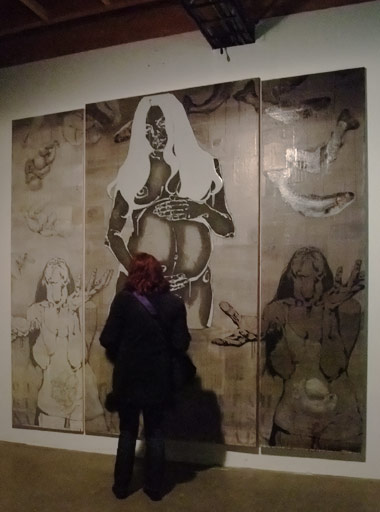 Some artists in the show responded to the themes of life and death, heaven and hell, or judgement such as Maayke Schuitema’s “Magna Mater”. Here a pregnant woman has replaced the crucifix and is flanked by scenes of women who are literally and symbollically juggling symbols of birth and death. Each woman’s womb bears either an symbol for life or death.
Some artists in the show responded to the themes of life and death, heaven and hell, or judgement such as Maayke Schuitema’s “Magna Mater”. Here a pregnant woman has replaced the crucifix and is flanked by scenes of women who are literally and symbollically juggling symbols of birth and death. Each woman’s womb bears either an symbol for life or death. Anyone familiar with contemporarty art can’t help but think of
Anyone familiar with contemporarty art can’t help but think of 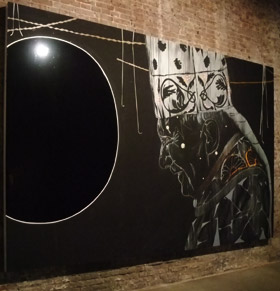
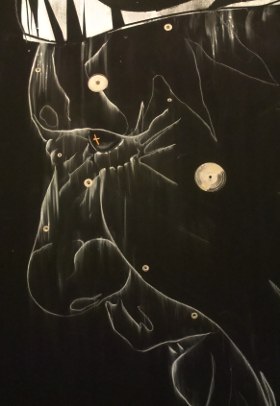
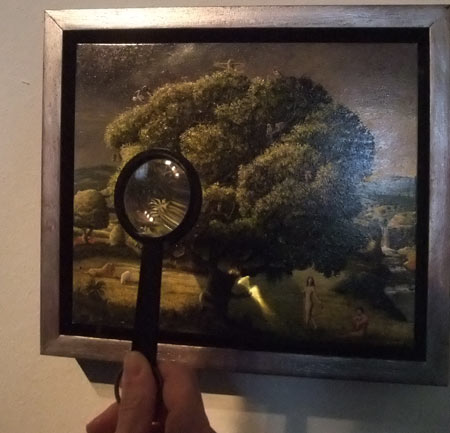

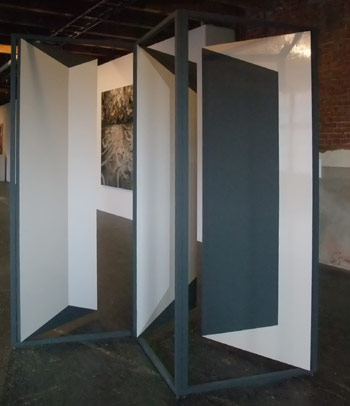
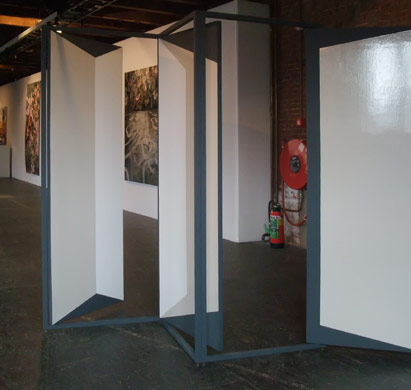
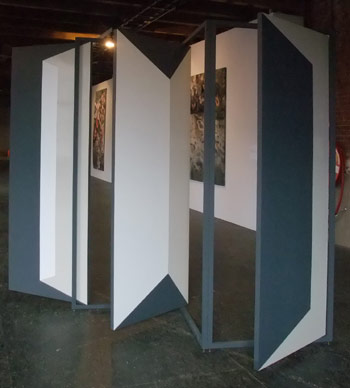
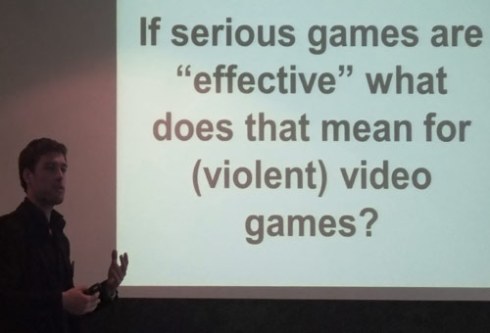 Dutch journalist and game researcher,
Dutch journalist and game researcher, 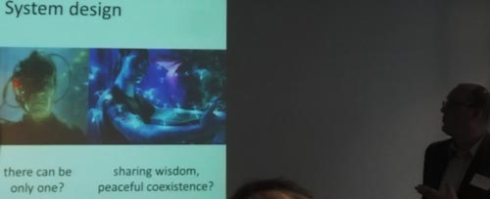

 Click on this to view it full size.
Click on this to view it full size.